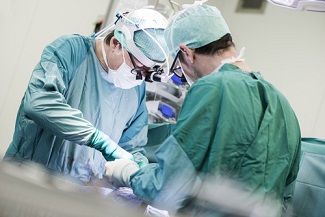Native joint septic arthritis is serious infection with an incidence of 4-12 per 100,000 person-years.1-2 Risk factors consist of diabetes mellitus, underlying joint disease such as rheumatoid arthritis or other inflammatory arthropathies, intravenous drug and alcohol use, cutaneous infections, and prior joint surgeries.2 Most cases are monoarticular and knees are most commonly affected. The gold standard for diagnosis of septic arthritis is pathogen identification from the affected joint.3
Treatment consists of surgical exploration and irrigation of the joint followed by pathogen-specific antibiotic therapy. Pathogen identification is a key component of the diagnosis and treatment of septic arthritis. In a clinically stable patient, it is common practice to hold antibiotics before obtaining specimens to optimize culture yield.4 While this is the dogma, there is no comprehensive study describing the effect of preoperative antibiotic therapy on the microbiologic yield of operative cultures.
Khodadadi and colleagues from the Mayo Clinic performed a retrospective study of patients diagnosed with septic arthritis from 2012 to 2021.5 Their goal was to determine the effect of preoperative antibiotic therapy on operative culture yield via a paired analysis of synovial aspirate cultures and operative cultures.
They also evaluated the dose and time-response effects of preoperative antibiotics on the predicted probability of positive operative cultures. They analyzed 299 patients who met the inclusion and exclusion criteria. The patients were then further divided into 2 different groups: 1 group who received preoperative antibiotics (255 patients); and the other group did not (44 patients). Most patients were male (63%) and White (94%). There was a total of 321 infected joints with the most commonly affected joints being knees (41%) and hips (11%). The most common organism was methicillin-susceptible Staphylococcus aureus (MSSA). Blood cultures were obtained in 266 patients (89%) with 123 patients (46%) having concurrent bacteremia with an average time to positivity of 13 hours.
There was a total of 215 (67%) positive preoperative synovial aspirate cultures and 188 (59%) positive operative cultures. Of the 47 cases with positive preoperative cultures that changed to negative after surgery, 95% (45/47) had received preoperative antibiotics. Streptococcus species were the most affected by preoperative antibiotics; representing 36% of this group (16/45).
Overall, this study demonstrated that among the group that received preoperative antibiotics, there was a statistically significant decrease in yield between preoperative (68%) and operative (57%) cultures (p<0.001). The logistic regression analysis revealed that patients who received preoperative antibiotics were twice as likely to have negative cultures compared to those who did not receive preoperative antibiotics (OR=2.12; 95% CI=1.24-3.64; p=0.006). They also demonstrated that more doses or longer duration of preoperative antibiotic therapy before surgical intervention, decreased the likelihood of positivity (p<0.001).
What You Need to Know
The study highlights a significant decrease in culture yield among patients who received preoperative antibiotics compared to those who did not.
The analysis also showed that the likelihood of positive cultures decreased with an increase in the number of doses or the duration of preoperative antibiotic therapy before surgical intervention. This suggests a dose and time-response effect of preoperative antibiotics on culture yield.
The findings reinforce the importance of cautious use of preoperative antibiotics due to their impact on culture yield.
Pathogen identification through cultures is a cornerstone in the field of infectious disease. This study echoes a message from a growing body of evidence reinforcing the cautious use of preoperative antibiotics given their significant impact on culture yield.4 It reinforces the practice of holding antibiotics before specimens are sent for cultures. There were approximately 11% of cases that turned from negative to positive cultures while holding preoperative antibiotics. It is unclear how many of those pathogens would have been missed if preoperative antibiotics were given. Note that some cases turned positive regardless of antibiotic exposure; probably because intraoperative specimen cultures are more sensitive to begin with. While patient outcomes of holding preoperative antibiotics are out of the scope of this study, it is reasonable to start appropriate empiric therapy after arthrocentesis as only a small fraction would theoretically turn positive after surgery.
This study also reinforces the microbial etiology of septic arthritis which could guide clinicians in minimizing the use of overly broad empiric antibiotics. This will help lessen adverse drug reactions and help combat antibiotic resistance. Lastly, this study showed that almost one-third of cases will be culture-negative.
References
- Kennedy N, Chambers ST, Nolan I, et al. Native Joint Septic Arthritis: Epidemiology, Clinical Features, and Microbiological Causes in a New Zealand Population. J Rheumatol. 2015;42(12):2392-2397. doi:10.3899/jrheum.150434
- McBride S, Mowbray J, Caughey W, et al. Epidemiology, Management, and Outcomes of Large and Small Native Joint Septic Arthritis in Adults, Clinical Infectious Diseases, 2020;70 (2):271–279, doi.org/10.1093/cid/ciz265
- Newman JH. Review of septic arthritis throughout the antibiotic era. Annals of the Rheumatic Diseases. 1976;35(3):198-205
- Ravn C, Neyt J, Benito N, Abreu MA, et al. Guideline for management of septic arthritis in native joints (SANJO). J Bone Jt Infect. 2023;8(1):29-37.
- Khodadadi RB, Damronglerd P, McHugh JW, et al. Effect of Preoperative Antibiotic Therapy on Operative Culture Yield for Diagnosis of Native Joint Septic Arthritis. Clin Infect Dis. Published online March 11, 2024. doi:10.1093/cid/ciae136

